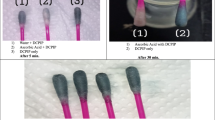Abstract
Quantitative and qualitative analyze of toxic and nutritional elements existing in different kinds of black tea (Camellia Sinensis) leaves available in Pakistan was conducted with calibration free/laser-induced breakdown spectroscopy (CF/LIBS). A Q-switched Nd:YAG laser employed to create micro-plasma on the tea sample surfaces. The quantitative analysis accomplished by studying the spectral emissions of plasma using a dedicated spectrometer. Iron, magnesium, sodium, potassium, calcium, aluminum, and zinc were measured as essential nutrients, while chromium, copper, manganese, nickel, and lead as toxic metals. In order to get precise and reliable analysis, the LIBS setup was optimized by performing various parametric dependence studies. The Boltzmann plot method was adopted for calculation the plasma temperature its average values are between ~ 7500 and 9000 K for all kinds of tea leaves. To find out the electron number density (Ne), the Stark broadened line of atmospheric hydrogen pea (Hα) was chosen and was found between 1.13 × 1017 cm−3 and 1.61 × 1017 cm−3. The laser-generated micro-plasma was optically thin, and the effect of self-absorption in spectral emission lines was found negligible. The LIBS results were verified by means of inductively coupled plasma/atomic emission spectroscopy (ICP/AES). The findings obtained using LIBS and ICP techniques displayed an excellent agreement which exhibit that LIBS is very good to for spectro-chemical analysis of food products.





Similar content being viewed by others
References
Martin, L.: Tea: the Drink that Changed the World. Tuttle Publishing, Clarendon (2011)
Saud, S.; Oud, A.: Heavy metal contents in tea and herb leaves. Pakistan J. Biol. Sci. 6, 202–208 (2003)
Qin, F.; Chen, W.: Lead and copper levels in tea samples marketed in Beijing, China. Bull. Environ. Contam. Toxicol. 79, 247–250 (2007)
Siddiqui, I.A.; Raisuddin, S.; Shukla, Y.: Protective effects of black tea extract on testosterone induced oxidative damage in prostate. Cancer Lett. 227, 125–132 (2005)
Fujita, H.; Yamagami, T.: Antihypercholesterolemic effect of Chinese black tea extract in human subjects with borderline hypercholesterolemia. Nutr. Res. 28, 450–456 (2008)
Takács, S.; Tatár, A.: Trace elements in the environment and in human organs: I. Methods and results. Environ. Res. 42, 312–320 (1987)
Hussain, I.; Khan, F.; Iqbal, Y.; Khalil, S.: Investigation of heavy metals in commercial tea brands. J. Chem. Soc. Pak. 28, 246–251 (2006)
Csikkel-Szolnoki, A.; Kiss, S.; Veres, S.: Elemental analysis of tea leaves by atomic spectroscopic methods. Magnes. Res. 7, 73–77 (1994)
Tokalıoğlu, Ş: Determination of trace elements in commonly consumed medicinal herbs by ICP-MS and multivariate analysis. Food Chem. 134, 2504–2508 (2012)
Ahmad, S.; Chaudhary, M.; Mannan, A.; Qureshi, I.: Determination of toxic elements in tea, leaves by instrumental neutron activation analysis. J. Radioanal. Chem. 78, 375–383 (1983)
Hussain, T.; Gondal, M.A.: Detection of toxic metals in waste water from dairy products plant using laser induced breakdown spectroscopy. Bullet. Env. Contam. Toxic. 80, 561–565 (2008)
Aldakheel, R.K.; Gondal, M.A.; Nasr, M.M.; Almessiere, M.A.; Idris, N.: Spectral analysis of Miracle Moringa tree leaves using X-ray photoelectron, laser induced breakdown and inductively coupled plasma-optical emission spectroscopic techniques. Talanta 217, 121062 (2020)
Rehan, I.; Gondal, M.; Rehan, K.: Determination of lead content in drilling fueled soil using laser induced spectral analysis and its cross validation using ICP/OES method. Talanta 182, 443–449 (2018)
Tognoni, E.; Cristoforetti, G.; Legnaioli, S.; Palleschi, V.; Salvetti, A.; Müller, M.; Panne, U.; Gornushkin, I.: A numerical study of expected accuracy and precision in calibration-free laser-induced breakdown spectroscopy in the assumption of ideal analytical plasma. Spectrochim. Acta, Part B 62, 1287–1302 (2007)
Rehan, I.; Gondal, M.; Rehan, K.; Sultana, S.; Dastageer, M.; Al-Adel, F.: LIBS for the detection of lead in ready to use henna paste and nutrients in fresh henna leaves and cultivated soils. Talanta 199, 203–211 (2019)
Gondal, M.A.; Dastageer, A.; Maslehuddin, M.; Alnehmi, A.J.; Al-Amoudi, O.S.B.: Detection of sulfur in the reinforced concrete structures using a dual pulsed LIBS system. Opt. Laser Technol. 44, 566–571 (2012)
Rehan, I.; Gondal, M.; Almessiere, M.; Dakheel, R.; Rehan, K.; Sultana, S.; Dastageer, M.: Nutritional and toxic elemental analysis of dry fruits using laser induced breakdown spectroscopy (LIBS) and inductively coupled plasma atomic emission spectrometry (ICP-AES). Saudi J. Biol. Sci. 28, 408–416 (2020)
Cirisan, M.; Cvejić, M.; Gavrilović, M.; Jovićević, S.; Konjević, N.; Hermann, J.: Stark broadening measurement of Al II lines in a laser-induced plasma. J. Quant. Spectrosc. Rad. Transf. 133, 652–662 (2014)
Gondal, M.A.; Nasr, M.M.; Ahmed, Z.; Yamani, Z.H.: Determination of trace elements in volcanic rock samples collected from cenozoic lava eruption sites using LIBS. J. Env. Sci. Health Part A 44, 528–535 (2009)
Ciucci, A.; Corsi, M.; Palleschi, V.; Rastelli, S.; Salvetti, A.; Tognoni, E.: New procedure for quantitative elemental analysis by laser-induced plasma spectroscopy. Appl. Spectrosc. 53, 960–964 (1999)
Wenlock, R.; Buss, D.; Dixon, E.: Trace nutrients: 2.* Manganese in British food. Br. J. Nutr. 41, 253–261 (1979)
Iqbal, Y.; Khalil, S.; Khan, F.; Hussain, I.: Investigation of heavy metals in commercial tea brands. J. Chem. Soc. Pak. 28, 246 (2011)
Acknowledgements
The authors are thankful to King Fahd University of Petroleum and Minerals to support this work and KACRAE under fellowship scheme.
Author information
Authors and Affiliations
Corresponding authors
Rights and permissions
About this article
Cite this article
Rehan, I., Gondal, M.A., Aldakheel, R.K. et al. Determination of Nutritional and Toxic Metals in Black Tea Leaves Using Calibration Free LIBS and ICP: AES Technique. Arab J Sci Eng 47, 7531–7539 (2022). https://doi.org/10.1007/s13369-021-06233-y
Received:
Accepted:
Published:
Issue Date:
DOI: https://doi.org/10.1007/s13369-021-06233-y




